Exporting Studio captures
Once you have edited your Depthkit Studio assets, you are ready to export. Learn more about the various export formats and settings below to choose the correct format and settings for your workflow.
In this page
Export location →
Export formats →
- Combined Per Pixel Video for Unity →
- Combined Per Pixel Image Sequences for custom encoding →
- Textured Geometry Sequences for visual effects and WebXR →
Combined Per Pixel Video export settings →
Combined Per Pixel Image Sequence export settings →
Textured Geometry Sequence export settings →
Exporting →
Next steps →

Export location

Specify the folder that the resulting export will be saved in. By default, this is a folder in your Depthkit project directory called _Exports.
Export formats
Combined Per Pixel Video for Unity

The combined-per-pixel format includes both the depth and color data in a single video file or image sequence that is optimized for playback using the Depthkit Expansion Packages for Unity. This produces three files in your specified export path:
- combined-per-pixel video: represents your color (top) and depth (bottom) streams as a video file optimized for Unity for performance friendly playback. You can also lay back your external audio recording into this video.
- poster image: a single frame pulled from the your clip, and displayed in Unity when your clip isn't playing.
- metadata file: holds your depth and capture data and is needed with the video clip for playback in the game engine.

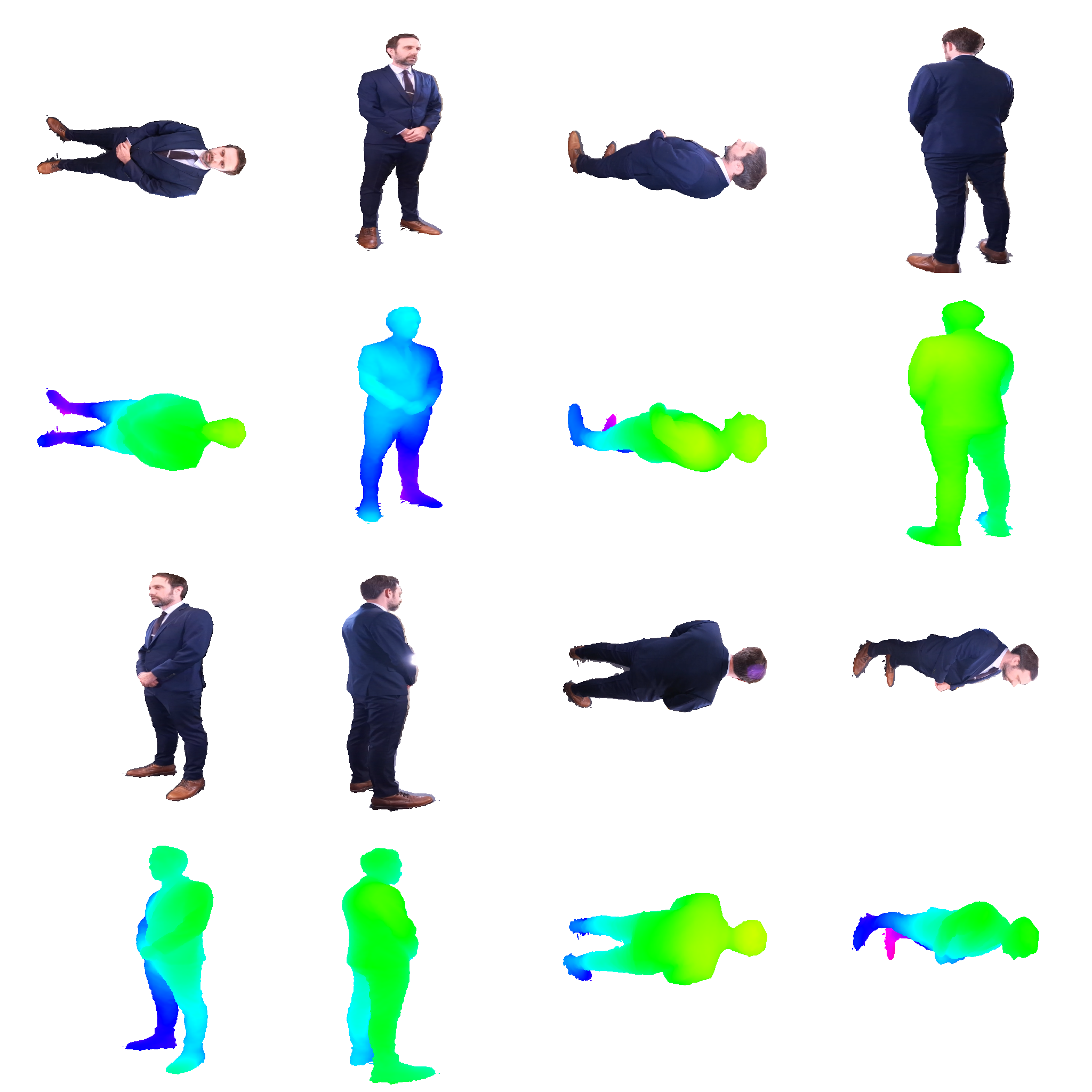
See the Combined Per Pixel Video export settings section below for more information.
Combined Per Pixel Image Sequences for custom encoding

This produces a folder with an image sequence in the same layout as the Combined per Pixel video, and an accompanying metadata file. Choose this option if you plan to encode your Combined per Pixel into a video using custom encoding settings in another tool like FFMPEG.
See the Combined Per Pixel Video export settings section below for more information.
Textured Geometry Sequences for visual effects and WebXR

If you are exporting for a visual effects workflow in a digital content creation tool like After Effects, Cinema 4D, or Houdini, you can also export your volumetric footage as an OBJ sequence or PLY sequence. This format produces a sequence, composed of three files per frame:
- OBJ/PLY: The geometry data of the frame.
- PNG/JPG Image: The color texture data of the frame.
- Material: A material file mapping the texture to the geometry.
If you are exporting for a streaming geometry sequence workflow for use in a WebGL pipeline like rendering in a web browser with Depthkit.js or 8th Wall, you can export your volumetric footage as a Draco-encoded mesh sequence. This format produces a sequence of DRC files, as well as a texture video or image sequence.

The exported folder containing the geometry sequence, and texture video

The contents of the geometry sequence folder
See the Textured Geometry Sequence export settings section below for more information.
Combined Per Pixel Video export settings
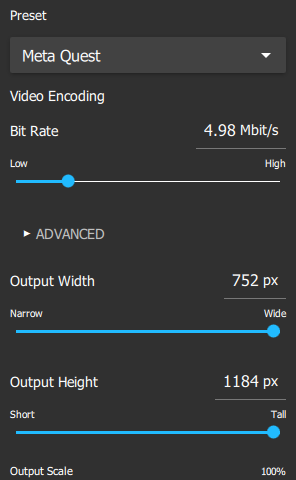
Bitrate: Set the target bitrate of your Combined Per Pixel Video. Lower bitrates will result in smaller files, but may introduce artifacts in the color and/or depth of your captures.
Preset: There are several advanced settings that have an impact on playback compatibility, quality and performance. Presets allow users to configure the advanced settings based on a known settings that work best for a given device.
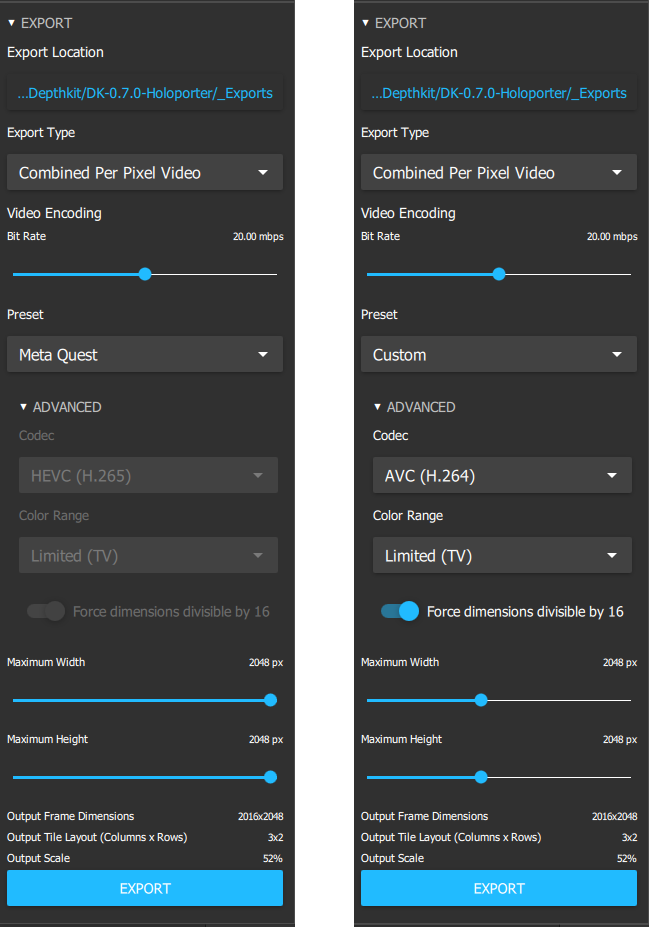
A comparison between having the Meta Quest preset selected (left) versus selecting custom export settings (right).
- Meta Quest applies to both Quest 2 and Quest Pro native playback through Unity.
- Apple Vision Pro sets codec and resolution constraints for performant playback when building a native application Apple Vision Pro in Unity.
- Custom allows the user to set custom advanced settings.
Maximum Resolution: These controls independently constrain the horizontal and vertical resolution of the exported Combined Per Pixel Video or Image Sequence. The maximum values can be reduced to accommodate different playback platforms and devices.
Advanced Settings
When Custom preset is selected, the following advanced options are available:
Codec: Choose the codec which best suits your publishing platform:
- AVC (H.264) provides the greatest compatibility for playback across various devices, but constrains the resolution and quality.
- HEVC (H.265) is a higher-efficiency codec which supports higher resolution, but is not universally supported for playback.
Windows 11 has HEVC support built in. However, on Windows 10, H.265 exports requires installation of the HEVC Videos Extension Plugin from the Windows Store
Color Range is a compatibility setting for some H.264 files to playback without distortion.
- Full (PC) is used in most playback scenarios, including desktop.
- Limited (TV) is required by some playback devices, including mobile devices like Meta Quest.
Force dimension divisible by 16 addresses an issue of visual errors on non-divisible by 16 frame dimensions on some Android devices, such as Meta Quest.
Once all of your settings are selected, proceed to the exporting section below to finalize the export.
Combined Per Pixel Image Sequence export settings
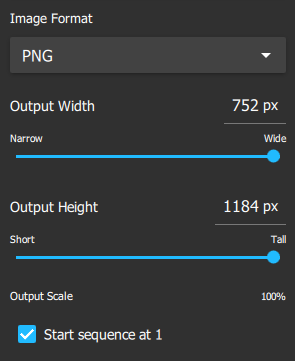
Image Format: Select between PNG files for higher quality, and JPG files for smaller file sizes.
Maximum Resolution: These controls independently constrain the horizontal and vertical resolution of the exported Combined Per Pixel Video or Image Sequence. The maximum values can be reduced to accommodate different playback platforms and devices.
Start sequence at 1: For image sequences, each exported file adopts the frame number from the source recording. Alternatively, you can override this and start the exported sequence at 1, depending on what's best for your workflow.
Once all of your settings are selected, proceed to the exporting section below to finalize the export.
Textured Geometry Sequence export settings
There a handful of settings which are available to tailor textured geometry exports for different workflows and pipelines.
Mesh Export Presets
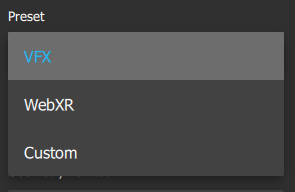
Depthkit offers presets to quickly load settings optimized for different workflows.
VFX: This preset is great for creating PLY sequences for visual effects tools (Houdini, C4D, etc.) which preserve lots of detail while keeping file sizes manageable.
WebXR: This preset is creates lightweight streaming-optimized Draco sequences which are great for sending over the internet and rendering on mobile devices.
Custom: This allows you to customize the format, mesh simplification, and texture settings yourself.
Custom Geometry Export Options
Simplify Mesh: Enabling this setting reduces the number of triangles of each frame of your geometry sequence, resulting in smaller files which play back more performantly. If this is disabled, the number and size of the triangles in the mesh will primarily be determined by the Mesh Density setting in the Surface Reconstruction Pane.
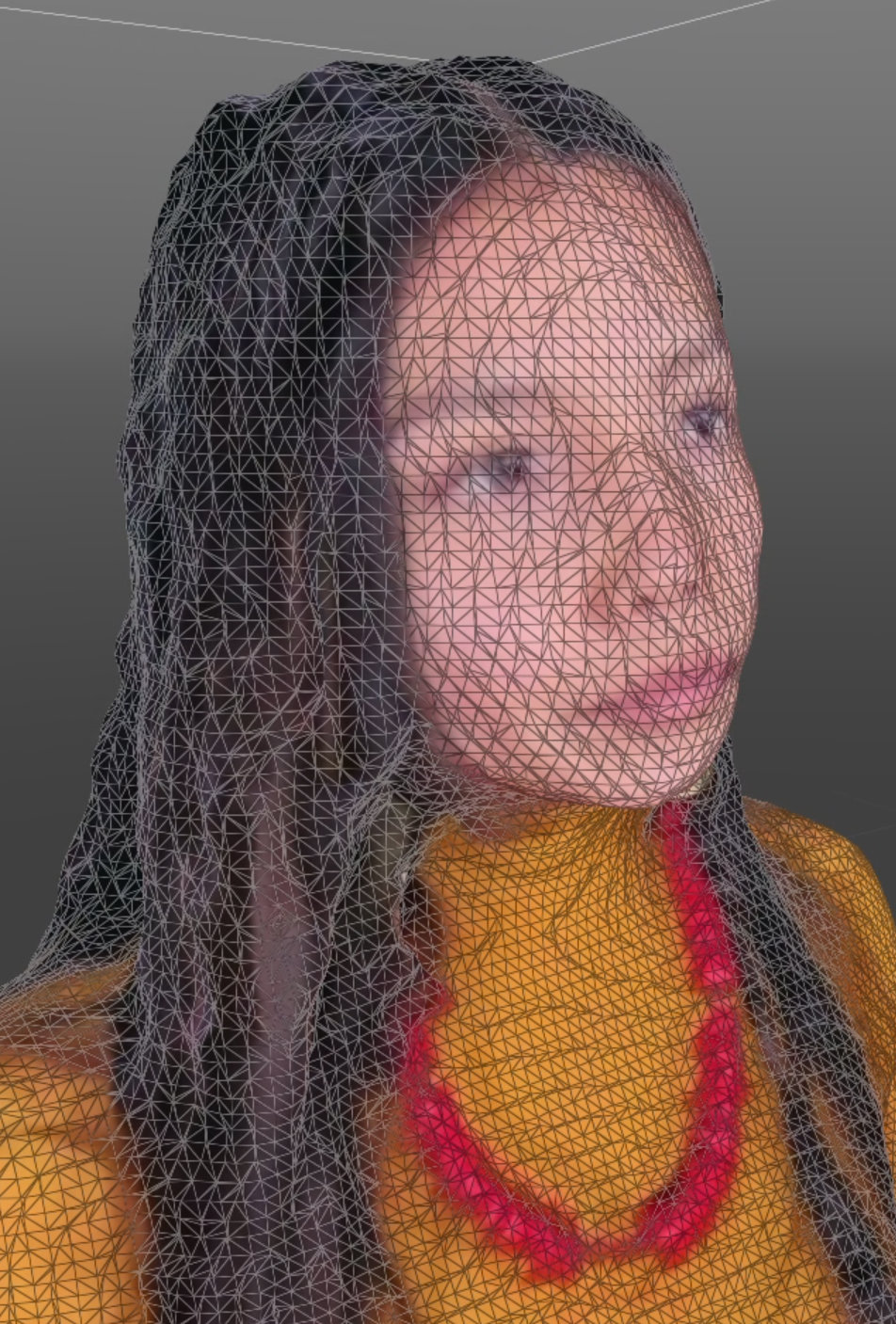
Mesh Simplification disabled. The size of these dense triangles is primarily determined by the Mesh Density setting in the Surface Reconstruction Pane.
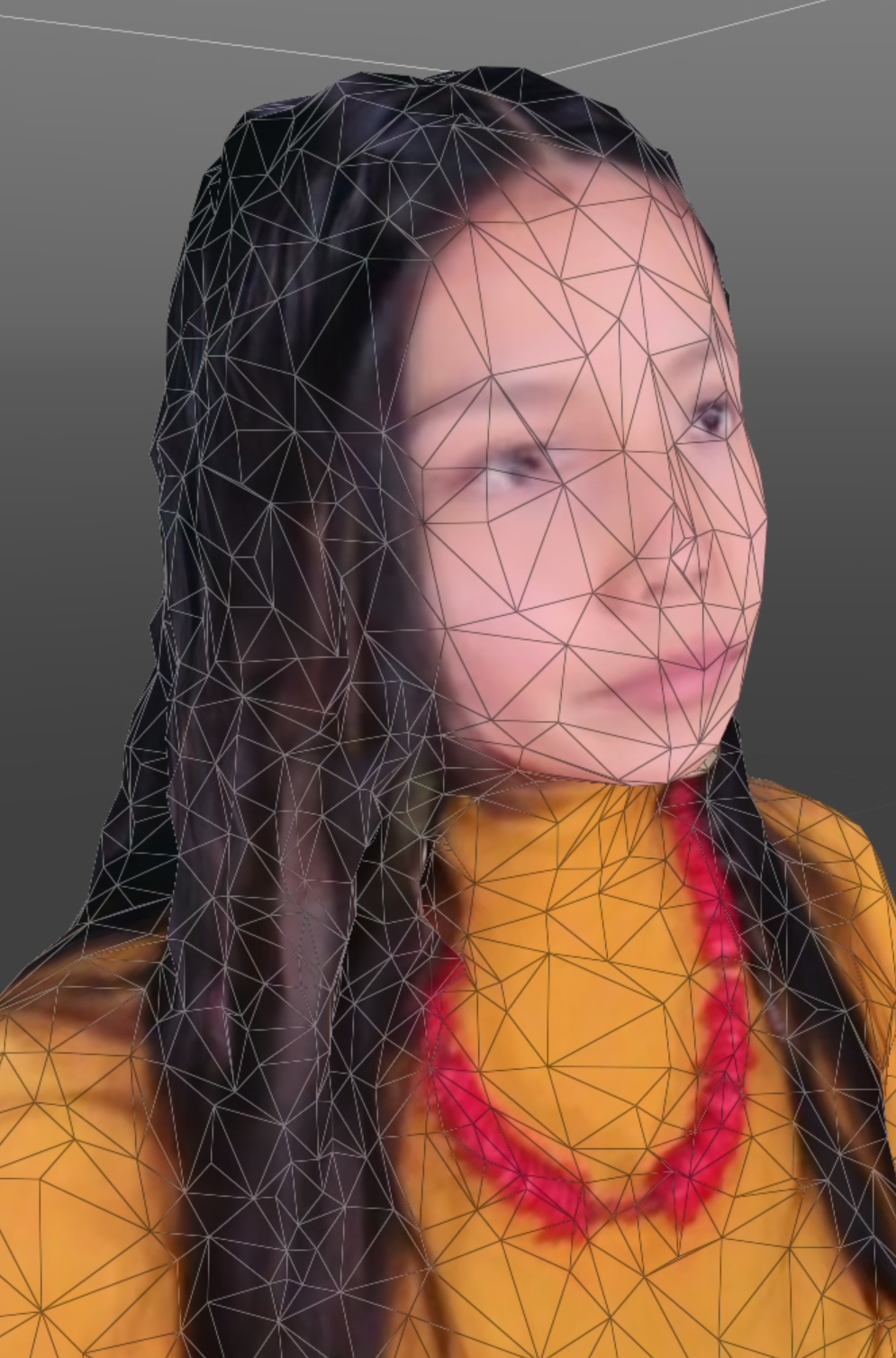
Mesh Simplification enabled. This mesh topology is determined by a combination of Mesh Density, Target Maximum Triangles, and Simplification Accuracy to generate a lower-poly mesh which is more optimized for streaming playback
Target Maximum Triangles: This setting assigns a target number of triangles for mesh simplification to aim for. A setting of 10,000 (10k) triangles is usually appropriate for playback on mobile devices & headsets, but you can set this higher if your playback platform is more performant. Adjusting toward ‘Sparse’ will reduce the number of triangles and file size of the export; Adjusting toward ‘Dense’ will increase the detail and fidelity of the geometry.
Simplification Accuracy: This setting determines how much mesh simplification is allowed to deviate from the Max Triangles setting in order to preserve accuracy. Adjusting toward ‘Accurate’ increases the number of triangles above the target threshold; Adjusting toward ‘Simplified’ will optimize the mesh at the expense of detail and fidelity.
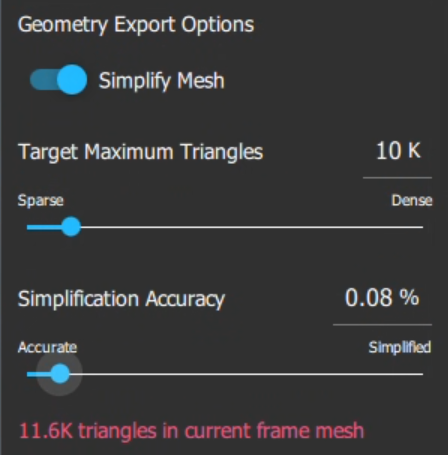
A warning will appear if your simplification settings produce a mesh that has more triangles than your target. Adjust the Simplification Accuracy toward ‘Simplified’ to address this.
Geometry Format: Draco files are the correct format for WebXR, but you can also export in PLY or OBJ formats for Visual Effects workflows or for compression through 3rd party players like Arcturus HoloEdit.
Relightable: Enabling this results in the geometry files including per-vertex normals, which results in more realistic lighting in 3D rendering environments, but also makes the files larger.
Texture Type: Determines if the texture is stored as a video or image sequence; Video is the required option for streaming playback through our Web player.
Bit Rate: This determines the bitrate of the video. Lower bitrates will result in a smaller texture video at the expense of compression artifacts.
Advanced > Codec: For video textures, choose between HEVC (H.265) which supports more efficient compression and higher resolutions, or AVC (H.264) which has more universal playback support. For playback on mobile devices and headsets, HEVC (H.265) is recommended.
Advanced > Color Range: is a compatibility setting for some H.264 files to playback without distortion. Full (PC) is used in most playback scenarios, including desktop; Limited (TV) is required by some playback devices, including mobile devices like Meta Quest.
Advanced > Force dimension divisible by 16: Addresses an issue of visual errors on non-divisible by 16 frame dimensions on some Android devices, such as Meta Quest.
Maximum Width/Height: These controls independently constrain the horizontal and vertical resolution of the exported texture video or image sequence. The maximum values can be reduced to accommodate different playback platforms and devices. The WebXR preset constrains these resolutions to 2048x2048 for universal support on mobile devices/headsets.
Maximum Resolution: These controls independently constrain the horizontal and vertical resolution of the exported Combined Per Pixel Video or Image Sequence. The maximum values can be reduced to accommodate different playback platforms and devices.
Start sequence at 1: When Texture Type is set to Image Sequences, each exported file adopts the frame number from the source recording. Alternatively, you can override this and start the exported sequence at 1, depending on what's best for your workflow.
Once all of your settings are selected, proceed to the exporting section below to finalize the export.
Exporting
Once you have selected your export location and format, then click the Export button and watch the blue progress bar in the timeline. This will only take a few moments.
Next steps
With your capture exported, you're now ready to publish your Depthkit Studio assets.
Updated 8 months ago
